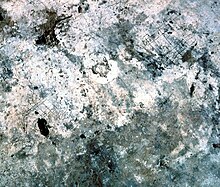Patolli

Patolli is a board game that originated in pre-Columbian Mesoamerica and was played by different peoples with similar rules. The game is similar to the Indian pachisi and the Korean yut .
history
There is evidence that the game was known to the founders of Teotihuacán , the Toltecs , the Aztecs and the Maya .
In the game, very high stakes were sometimes made, which in extreme cases also affected one's own home or family and sometimes led to slavery.
In 1521, after the Spanish conquest , the game was banned because the Spanish ecclesiastical authority saw it as a pagan game with strong religious significance. Many of the playmats and accessories that were still in existence at the time were destroyed by the Spaniards, and people who violated the ban on playing were severely punished.
Symbolism and religion
The game probably has symbolism related to calendar cycles in it. So it symbolized the movement of the heavenly bodies. The number 4, which plays a major role, is also striking. There are four fields in the middle, it has four dice beans (according to Glonnegger ) and four play arms. Possibly. this symbolizes the cardinal points and / or the seasons.
The Indians believed that the god Macuilxochitl influenced the game. He was called during the game. Macuilxochitl is the "god of the five flowers". The number 5 is also included in the game board. For the arms there are five fields from the marked fields to the middle. At Parlett there were five beans to dice.
Game flow
Patolli was played on mats ( called petate ) with an X as a playing field of four cross-shaped arms. The playing field consists of a total of 64 fields. The tracks have eight fields each, which are arranged in parallel. In the middle there are four more fields. Two people or two groups played against each other. The game was rolled with four or five beans ( called patolli ), which were marked with a white dot or a hole on one side, the game pieces consisted of red and blue beans. You had to move your own figures from the center over three arms before you won. On one arm you were spared the enemy, but on two arms there was a possibility of collision.
It's not entirely clear what number the bean tosses were. These were probably the correct moves per throw:
| Number of points above | Steps forward |
|---|---|
| 0 | 20th |
| 1 | 1 |
| 2 | 2 |
| 3 | 3 |
| 4th | 4th |
| 5 | 10 |
What could also not be fully clarified are the functions of the fields behind the triangular markings. We no longer know whether they also served as train fields or whether they had a different meaning. If it were the case that these were not used as train spaces, the game would only have 44 train spaces in total.
variants
Archaeological excavations have found Patolli fields that had been scratched into the stucco floor, for example in Teotihuacán , Palenque and Tikal, and in western Mexico. However, these games had a different pattern. Even in historical times playing Tarascan of Michoacán with a similar performance pattern.
Web links
Individual evidence
- ^ A b c d Erwin Glonnegger , The Games Book, board and placement games from all over the world, origin, rules, history , Ravensburger Buchverlag, Ravensburg 1988, ISBN 3-473-42601-6
- ↑ a b c d e f David Parlett , The Oxford History of Board Games , Oxford and New York 1999, ISBN 0-19-212998-8
- ↑ Joseph B. Mountjoy: Patolli , in: The Oxford Encyclopedia of Mesoamerican cultures . Oxford, University Press 2001, ISBN 0-19-510815-9 , Vol. 2 p. 448

